Unique guano innovation yields information on bat populations

Two Northern Arizona University scientists have created a tool to identify bat species using DNA in guano, a non-invasive method that can aid in preservation of endangered species. Because bats disperse seeds, pollinate plants and control insect populations, officials regularly consider bats when making decisions that could affect habitats.
Postdoctoral research associate Faith Walker and Professor Carol Chambers' Species from Feces instrument will provide data to national park officials, mining companies, land managers and organizations including Bat Conservation International, who want to know if endangered bat species are inhabiting particular caves.If a land manager wants to know if they can close a mine because it might be dangerous to the public, we can take some guano and determine which bats are using the mine," said Chambers. When needed, officials could close a mine to people while taking extra steps to keep it accessible to bats.
The interest in bat health is increasing with the east-to-west migration of White-nose syndrome, responsible for killing millions of bats in North America. The species most affected by the deadly fungus is the little brown bat, which is similar genetically to the Arizona brown bat.
White-nose syndrome may be less lethal in the Southwest than in the Northwest, where hundreds of thousands of hibernating bats share a single cave. In Arizona, bat populations are dispersed, a fact that may help their survival rates when the fungus reaches the region; however, the fungus will likely thrive in the microclimates of many southwestern caves.
Species from Feces will help researchers create a baseline of bat populations in different areas including national parks and the system could be used worldwide. There are more than 1,000 bat species, making up about 25 percent of all mammal species.
"People go into caves and mines and they want to know which bat species are there but all they'll find is guano, usually," said Walker, who described Species from Feces as a mini bar code that targets the bat DNA but not the insect DNA found within the guano.
The Species from Feces tool is one component of a larger ambition: to create a bat institute housing genomic information and projects vital to bat conservation worldwide.
Provided by Northern Arizona University

















